|
|
Welcome to my travel log! You will find here a lot more than in the travel reports, stripped from political correctness. Enjoy! 
Apr 03, 2006 02:00 PM Abomey - former capital of the feared Kingdom of Dahomey
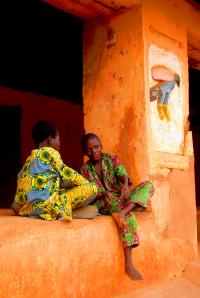 Before the state of Benin, the Kingdom of Dahomey ruled the area. It used to be the most feared kingdom of all Africa, which became infamous by selling people to the Portuguese into slavery. Voodoo and magic flourish there as well, and many people ended up being sacrificed to please the king’s ancestors.
Before the state of Benin, the Kingdom of Dahomey ruled the area. It used to be the most feared kingdom of all Africa, which became infamous by selling people to the Portuguese into slavery. Voodoo and magic flourish there as well, and many people ended up being sacrificed to please the king’s ancestors.
As Dahomey's kings embarked on wars to expand their territory, they began using rifles and other firearms traded with French and Spanish slave-traders for young men captured in battle, who fetched a very high price from the European slave-merchants.
As one of West Africa's principal slave states, Dahomey became extremely unpopular with neighbouring peoples. One of the historians estimated that the king of Dahomey had been making GBP 250,000 per year by selling captive African soldiers and even his own people to the European slave-traders. Most of this money was spent on British-made firearms and alcohol.
Under the French rule, Dahomey was known as French Dahomey, and when it gained independence, the Republic of Dahomey. It changed its name to Benin in 1975.
The exemplary republic promoting democracy in Africa thrives, yet, as I mentioned before, the king remains. He is no longer cruel and evil, and in fact has got little power. A symbolic, more than anything else, figure, the king gives audiences and loves to chat, allegedly. I saw the king in Porto Novo, accompanied by his wives (although he did no longer had hundreds of them) and a security guard - pictured on the left.
It is nowadays accepted that there were thirteen kings of Dahomey, and each of them had their own symbol. One of the kings, Adandozon, who ruled between 1797 and 1818, had been omitted from the charts. It is believed he had been cursed. He was the most cruel and evil of all Dahomian kings. He was known to castrate men and feed their members to hyenas, and to slit open pregnant women and perform magic craft on their foetuses. The name of Adandozon, who was unacceptably against the slave trade, is not longer spoken, and many actually fear to say this name.
The kingdom had its capital in Abomey, and since it was a taboo to live in the house of the father, or a previous king, there were thirteen royal palaces built within the wall of the royal city. They were destroyed by the last king of Dahomey to prevent the French capturing them, and only two remain, or had been to date restored - the palace of king Glélé and Ghézo.
The thing is that the king was never considered dead. So, when a king passed away, he was considered resting or travelling. And this was also a reason why the new king had to build his own palace, the palace for his wives (and entire harem in fact), and all the rest.
The tour of the palaces included a visit to one of the travelling kings, His Majesty King Glélé - to his very bedroom. Food was still being brought to his bed on a regular basis. I enjoyed the audience, but I thought one thing was a bit too much. I had to take my boots off and socks off and walk on the dirt around the compound of the travelling king Glélé.
The royal museum in Abomey had a very impressive collection of original royal items. I was astounded to see how many items survived to this day. There were carriages, thrones (decorated with human sculls) and royal insignia. All of them were considered sacred and photography inside the inner walls was strictly forbidden.
Between the outer and inner walls, there was an art village, where locals sold cloth, batiks, and some seriously poor quality brass work. I did not buy anything, blaming it on a lack of staff at the bar, where I wanted to get a drink.
Outside the royal city, I met a few kids playing cards. That was one of the most surreal episodes of my trip. I could never expect card playing children around a royal complex, which was considered sacred and where photography was outlawed. The kids encouraged me to take a picture of them and within seconds I was surrounded by dozens of kids who all wanted to be photographed. I learnt to be careful with situations like this, because the kids in Africa do charge the modelling fee whenever their picture is taken. Sometimes the fee is a pen or something similar, but I simply did not have enough ‘gifts’.
Now, after the trip, I think I should have browsed more in Abomey. It did not look excessively attractive, but like Timbuktu of Mali (which I almost visited) Abomey is a legendary town in Africa, and I should have learnt it better. My issue was that apart from the royal palaces, Abomey had nothing else to offer but dusty red streets and red mud crumbling houses.
|
Apr 02, 2006 02:00 PM Ouidah - the departure point
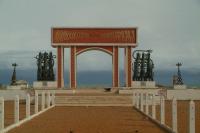 Ouidah, the capital of voodoo, was a dead town with almost nothing to do. The remains of the Portuguese fort were a joke. It was a simple villa with childish expositions, which supposed to make it a museum.
Ouidah, the capital of voodoo, was a dead town with almost nothing to do. The remains of the Portuguese fort were a joke. It was a simple villa with childish expositions, which supposed to make it a museum.
For the entire day, there was no electricity in the whole town. I had my first candle light dinner of this trip, since the hotel had no power generator. Well, it was a mini torch light dinner at first, before the personnel could find a candle.
I strolled about the town in the late afternoon, which just made me sweat, sweat, sweat! I could not believe that guidebooks could give positive descriptions of the town.
The Brazilian House was another tourist trap. I have no words to say how disappointed I was. The exposition of the Africa’s women was pathetic and hugely overstated. It suggested that men did nothing and women did everything. How about the men weaving kente in Ghana? They have been obviously and conveniently forgotten.
Well, this was my first impression of the town. Fortunately, my second impression was much better.
It might have been over-advertised but it was pleasantly unrushed. A few areas were kept clean and tidy. And organised. There were at least three larger squares, paved neatly. One between the Catholic cathedral and the voodoo Temple of Pythons. Another at the site of former forts, and yet another on the way to the beach.
The Ouidah beach was nice but dirty. Maybe I went there on a wrong day, but the waves were so strong that they generated a spray making the beach somewhat unpleasant. On a perfect super sunny and calm day, the beach must be great. It was wide and the sand was of the colour of gold. As everywhere in the area, the locals managed to spare the tall, graceful coconut palmtrees. In many other African countries the palmtrees had often found their destiny in charcoal making ovens.
Two horrendous concrete structures disturbed the attractiveness of the beach very successfully. One of them was the Gate of No Return, which unbelievably was labelled with the UNESCO contribution. It was representing the point from which countless men, women and children had been shipped across the Atlantic. The other one was the Gate of Return, which represented the fact that many descendants of the slaves came back, if only to visit the country of their ancestors. Both were thoroughly hideous. They looked like they were built by a very unhappy amateur, who got himself (or herself) completely inebriated, totally stoned and on his (or hers) worst hangover ever, created those doubtful pieces of art.
I had a map of Ouidah, a primitive one, I have to say, and when I followed it strictly, I could not find anything I was looking for. I began wondering whether the person who drew the map had ever been to Ouidah.
This way, I wandered about the town pointlessly and kept discovering various places, although I never found the sacred forest, in which the good and wise king, turned in to large tree, was hiding from the cruel and evil king. I did find a very pleasant drink bar, though.
It was a very hot and humid evening, my sweat was dripping off my nose and and kept travelling down my own personal ‘Mariana Trench’, and I really needed a drink. I was the only customer there and I ordered one Pepsi and one beer. I mixed it and remembered the days I was introduced to drinking alcohol. But then, cola and beer was also mixed with vodka. So this was not the same.
A lady with a basket on her head entered the bar, which was partially open-air venue and asked me if I wanted sweets or chocolate. At first, I refused but then I thought that maybe I could get some chocolate for myself and some biscuits for the kids in the streets.
I was shocked to find out that she actually did not have any chocolate and what she meant by chocolate were cocoa filled or covered biscuits and cookies. Fortunately, she had some salty crackers as well, and therefore I could also get something for myself.
|
Apr 02, 2006 02:00 PM Togoville - waste of time? Hmm.. perhaps.
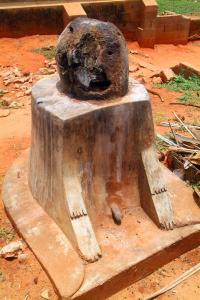 He did come at 8 a.m. He was not even late, but he came on a zemi. I mean zemi brought him. I asked him where the taxi was and he looked at me like he did not know what I was talking about. I repeated the entire conversation we had the night before. He nodded and said that I should go with him to his house, so he could drop his bag. I said no, and told him to harry up with the taxi.
He did come at 8 a.m. He was not even late, but he came on a zemi. I mean zemi brought him. I asked him where the taxi was and he looked at me like he did not know what I was talking about. I repeated the entire conversation we had the night before. He nodded and said that I should go with him to his house, so he could drop his bag. I said no, and told him to harry up with the taxi.
He came back after about half an hour with his brother. There was no sign of a taxi. When he said that he still needed to go to his house, I got annoyed. I told him that he obviously did not understand me at all.
I eventually ended up in a taxi and almost travelled as far back as Lomé to exchange money. When I said I needed to go to town to change money. He assumed I meant the capital city and not the poor Aného town, where there was a bank, too.
I managed to turn the car around but then the driver refused to take me to Togoville and I had to change vehicles. By that time I was seriously angry.
This whole situation might have contributed to my feeling that Togoville was a tourist trap and a joke. Apart from a reasonably good looking church and a few voodoo shrines there was nothing to it. It was a dirty village. That’s all.
|
Apr 01, 2006 02:00 PM Aneho - what to do there?
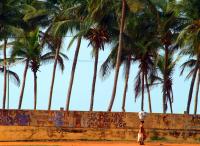 I did not take my travel guide on Togo and I forgot why I actually went to Aného. I definitely struggled without the guidebook, as I looked around I could not figure out what exactly there was to see.
I did not take my travel guide on Togo and I forgot why I actually went to Aného. I definitely struggled without the guidebook, as I looked around I could not figure out what exactly there was to see.
My first impression, which I actually recorded about Aného was - What the hell?
I stayed at the Oasis Hotel & Restaurant. The restaurant was superb and its terrace opened up at a lagoon.
When I arrived at about 4 p.m. the place was still buzzing with people, mainly white French, finishing their meals. The sight of them encouraged me a little and I thought that there must be something about Togo that I obviously was not realising that attracted travellers. I just needed to discover the secret and enjoy myself.
So, I embarked on an adventure and took a stroll around the town. I was not sure, which way to go, as the centre of the town was hard to spot. I stood for a while at the bridge over the lagoon and watched the sunset and fishermen throwing nets on the lagoon and the lake.
I noticed a tidy and nicely arranged waterfront park near the hotel I was staying at. I went back there and enjoyed the shade of the palmtrees.
After a while a young man approached me and start speaking in French asking me my name, nationality, etc. - the usual stuff. I politely replied but made an indication that I would prefer English. He claimed he spoke some English. So, I told him that I was looking for a taxi to take me to Togoville and asked him whether he would be able to arrange one. He said yes.
I knew I could count on the locals’ curiosity. What I did not know was that he did not understand what I asked him to do.
He invited me to see his room. I met his brothers and sisters, one of whom asked me for money! She barely met me, did not know who I really was and yet she thought I was stupid enough to give people money for nothing. She was reasonably well dressed and was lying down by the house. I did not take that very well.
Before we parted, I again explained what I expected him to do. I told him that I needed a taxi to: first, to take me to a place to exchange money; then, to Togoville, Glidji village and to the border with Benin. We agreed he would come to the hotel the next morning at 8 o’clock.
|
Apr 01, 2006 02:00 PM Lome - the capital of Togo
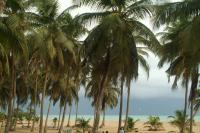 The capital of Togo, strangely adjacent to the Ghanaian border appeared to me as a busy place and the only town in Togo. Well, when the Togolese said that they were travelling to town, they could only mean the capital.
The capital of Togo, strangely adjacent to the Ghanaian border appeared to me as a busy place and the only town in Togo. Well, when the Togolese said that they were travelling to town, they could only mean the capital.
I tried to steer away from this busy city, which had nothing on record that would make it worth exploring. Yet, there was one thing that impressed me. It was the beach. It was vastly wide, surprisingly clean, the sand had a colour of gold and the tall coconut palms made the picture perfect.
The beach appeared to have no end. As I travelled east for about forty kilometres, it was still there, interrupted once by a fishing harbour and a cement factory.
|
Mar 31, 2006 02:00 PM Cape Coast - my favourite beach
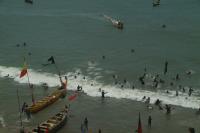 I came back to Cape Coast on one occasion and then I discovered a superb view of the town and the castle from the eastern part of the town. I was picking up two of my football players and spotted that view. When I was passing, I unexpectedly stopped the car and stormed up a small hill to take a picture. The guys in the car thought I was mad.
I came back to Cape Coast on one occasion and then I discovered a superb view of the town and the castle from the eastern part of the town. I was picking up two of my football players and spotted that view. When I was passing, I unexpectedly stopped the car and stormed up a small hill to take a picture. The guys in the car thought I was mad.
By that time, my favourite stretch of coastal road of Ghana was the one between Cape Coast and Elmina. It was planted with tall thin palm trees and resembled one of Los Angeles’s boulevards, but its supremacy lied with the immediate vicinity of a golden beach.
|
Mar 31, 2006 02:00 PM Komenda - two forts and a perfect beach
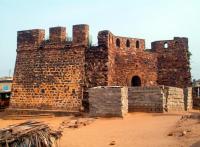 It was not really in my plans, but as soon as I heard that the ruined fort in Komenda was extensive, I decided to go. It was a very short hop from Elmina anyway, so I did it in the morning, before one of the Panya’s matches. In fact, one of the strikers, Frederick, went with me. He attended one of the schools there and knew the town well, and became a teacher himself, teaching at the Elmina’s Christ Cares Prep School.
It was not really in my plans, but as soon as I heard that the ruined fort in Komenda was extensive, I decided to go. It was a very short hop from Elmina anyway, so I did it in the morning, before one of the Panya’s matches. In fact, one of the strikers, Frederick, went with me. He attended one of the schools there and knew the town well, and became a teacher himself, teaching at the Elmina’s Christ Cares Prep School.
I was so glad that I went, because there were two ruined forts in Komenda. One was Dutch, Fort Vredenburg and the other, across the river, British, called Fort English.
The ruins of Fort Vredenburg were vast. It must have been a massive and mighty fort, complementing its sister in Elmina and rivalling the British one next door. I could see some bricks laid out around it but I could not confirm whether they were destined to restore the stronghold or not. They might have been there to build a house, perhaps.
There was one thing that outrated the fortress - the beach. Its golden sand and tall palmtrees in great numbers looked like they were taken from a TV commercial.
I insisted to see the British fort, too, which meant a rather hot trek across the river. Since the bridge was broken, it was uncertain how I was going to get there. Funny enough, the river actually did not managed to enter the ocean and it was stuck at one of the sand dunes, maybe a hundred yards from the Atlantic! So, it was very easy to cross to the other side.
As I was ploughing through the sand, amongst the many fishing boats, which most definitely were being unloaded, I could tell by the excruciating fishy smell, Frederick said that I should be careful. Apparently, that side of Komenda was not very friendly. I asked him why. He did not tell me.
Fort English disappointed me. The ruin was totally unrecognisable and if I were passing through there (theoretically) by chance, I would not even suspect that a few piled up bricks were a fort one day.
Furthermore, the town grew around the former fortress that I had to enter people’s households so I could have a look at the total ruin. The Dutch fort at the other side of the river might be restored one day, it will actually be impossible with the British one.
|
Mar 31, 2006 02:00 PM Elmina - 'my' football team
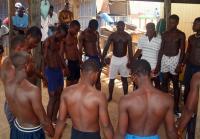 I did go back to Elmina to see my football team play again. They were ecstatic to see me and invited me to their camp. What I experienced at the camp was the most engaging occurrence of my trip.
I did go back to Elmina to see my football team play again. They were ecstatic to see me and invited me to their camp. What I experienced at the camp was the most engaging occurrence of my trip.
The guys gathered in a dark and extremely hot theatre and prepared for the next day game. The stood in a circle, sang and clapped their hands for about twenty minutes. Then, they held their hands and prayed for about half an hour or so. They prayed aloud. The first prayers were said together in a few local languages and then in English. Then they prayed individually but still standing in a circle and still holding hands. Some of the boys prayed with so much passion that I find it difficult to describe. They had their eyes closed and their faces struggled to hold all that emotion that was being expressed.
The thing was that at least two lads were Muslim. They fully participated in all the prayers, they sang together and held hands. The session was not over until they also said their Muslim prayers in Arabic. The hands remained being held tight and all the guys fully participated in their prayers, too.
This must have been the greatest harmony, fellowship and amicability, to which I have ever been a witness! It was for me the most moving, heartwarming and touching experience. I have to say that I knew about such harmony in West Africa. I experienced it before in The Gambia, but for the first time ever, did I see Christians praying together with the Muslims holding hands.
After the match, which the guys drew (also for the first time in the season) I told them what I felt at the camp the night before. They told me that they prayed for me, too.
I learned that Panya FC had players from outside Elmina. Three of them came from Cape Coast, at least two from Takoradi, one from Mankessim and one even from Kumasi. That is far from Elmina and it took a lot of effort and I am sure was not cheap for them to travel those distances.
I did ask the lads why they were doing it. Surely there were good football teams in Cape Coast, definitely in Takoradi and Kumasi. They told me that they had chosen to play in Panya FC because they were friends with some of the Elmina players.
Right before the match, I saw how the guys pray again. It is some sort of ritual they adopted although many of them, if not all, were deeply religious. The team usually chooses a spot in Elmina, be it one of the courtyards of the castle or a resting hut near the beach, and get prepared there. They sing together and pray.
Then, they all jumped to the ocean and prayed briefly there. Also in a circle. They told me that they always did that. So, this one I could definitely call a ritual. And I liked that, at least I could see that they had something special going on. The other teams in Elmina did not go swimming together before the match, because I would see them. Elmina is a small town, there were only three beaches around.
The guys invited me to their prayers and I joined once. They also wanted me to swim with them, but I had to say no. I had too much photographic equipment with me, which did not stand moisture gladly.
I was amazed how dedicated the lads were to football and to their club. Many of the lads had no other job but played football, which did not pay them anything. How they kept surviving was beyond my understanding.
|
Mar 30, 2006 02:00 PM Bonwire - cloth making
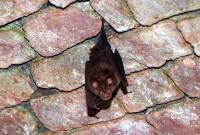 Although I was told to avoid Bonwire, I still went there to see the weaving of kente, a locally produced cloth.
Although I was told to avoid Bonwire, I still went there to see the weaving of kente, a locally produced cloth.
I made it clear to all guys in the village, and to Philip as well - just in case, that I was not going to buy anything and I just wanted to see how the Ashanti’s kente was manufactured. And this was fine.
I learnt that only boys did the weaving, and I was invited to see some of them in action. It was hard, manual work.
A few local guys led the way and I met a few weavers and took a few pictures. I left them with small change. This encouraged the leading boys to expect that I would potentially part with some more of my money for their benefit.
They asked me my name and some of them started secretly weaving small key holders for me. The key holder would be interesting colourful and would spell my name! Half way through the work, they revealed to me what they were doing and said that they expected me to by it from them. I checked their work and saw they started spelling my name with ‘Ch’ for Chris. I had an illegitimate pleasure of breaking it to them that my name was not spelled with ‘Ch’. Then, asked Philip what I was talking about - for I said that my name was ‘Chris’. With the widest grin I have ever seen, Philip told the lads that I spelled my name ‘Krys’. They were disappointed...
|
Mar 30, 2006 02:00 PM Basease - old obosom's house
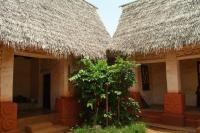 I rushed to Besease to see the greatest example of Ashanti architecture in one piece, which was turned into a museum.
I rushed to Besease to see the greatest example of Ashanti architecture in one piece, which was turned into a museum.
The former Obosomfie was kept in an immaculate state and visiting it was electrifying. The courtyard was maintained exactly in the form it would be if it was still fully operational home of the Obosom and Okomfo. The walls were painted in two colours - cream (perhaps it should be white) and red. Many tools, which would be associated in performing the necessary ceremonies, were planted around the courtyard.
The walls of the museum with their old photographs provided a glance to what Kumasi looked like in the nineteenth century and what the Okomfo ceremonies would look like. Some of the photographs pictured priests with their powdered faces.
I wanted to take a picture like that, so I enquired at the museum, where I could find a working Okomfo on that day.
The museum guard gave me a name of a village and telephone number to one of Okomfo’s assistants. I went there.
The priest was working in a regular house, which worked as a temple. It was hard to find it. They knew that I was coming and I explained that I just wanted to have a quick chat with the Okomfo and take a few pictures. They said that this should be fine and let me wait. There were a few locals waiting to see the priest, so I was put in the line.
People came and went. The Okomfo took a break, shook my hand and I was still kept waiting. Then, I told Philip that I lost my patience and that I would want to leave soon.
Eventually, I was invited inside. The room was very dark. Tools hung around on the walls would be more appropriate for a slaughter house rather than a temple. The Okomfo was seating on the floor powdered all over, and not only on his face, and his two assistants sat on stools on his either side. One of them acted as an interpreter.
I offered my Schnapps, which was happily accepted. Then, I was asked for money, because I wanted to take pictures. So, I gave them 20,000 cedis, which were happily accepted again. And... the Okomfo did not allow for the pictures to be taken! Bastard!
I asked a few courtesy questions, like why, who, when. Yet, I felt that the guys were more curious of finding things about me. Since I was disappointed I wanted to leave as soon as possible.
|
Page:
 68 69 70 71 72 73 74 75 76 77 78
68 69 70 71 72 73 74 75 76 77 78

|
|
|
